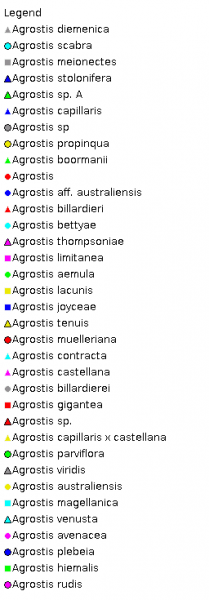Agrostis L.,. Sp. Pl. 61 (1753).
Derivation:.
Ancient Greek name for a forage grass, from Greek agros (a field).
Taxonomic revisions, nomenclatural references:. J.W.Vickery, Contr. N.S.W. Natl.
Herb.1: 281–295 (1941).
Key references
(keys and floras):. G.Bentham, Flora Australiensis 7: 575–577
(1878); C.A.Gardner, Flora of Western Australia 1 Gramineae
151–156 (1952); E.E.Henty, Manual Grasses New Guinea 25 (1969);
M.Lazarides, Flora of Central Australia 435 (1981); J.C.Tothill and
J.B.Hacker, Grasses of Southern Queensland 82–84(1983); J.P.Jessop, Flora of South
Australia 4: 1914–1917(1986); B.K.Simon, Key to Australian Grasses
61–63 (1993); S.W.L.Jacobs and S.M.Hastings, Flora of New South Wales 4:
569–574(1993); N.G.Walsh, Flora of Victoria 2: 467–476 (1994);
D.I.Morris, Student's Flora of Tasmania 4B: 254–264 (1994);
E.Edgar and H.E.Connor, Flora of New Zealand 5: 225–241 (2000); D.Sharp
and B.K.Simon, AusGrass (2002); J.P.Jessop, Grasses of South
Australia 183–186 (2006); S.W.L.Jacobs, R.D.B.Whalley & D.J.B.Wheeler, Grasses
of New South Wales, 4th Ed, 107–111 (2008); A.Wilson (ed.), Flora of
Australia 44A: Poaceae 2: 163–170 (2009).
W.D.Clayton & S.A.Renvoize, Genera Graminum (1986), genus (197).
Native and
naturalised. About 26 species, from temperate regions. About 26 species in
Australia, WA, NT, SA, Qld, NSW, Vic, and Tas. Also New Guinea, Malesia and New
Zealand.
Habit. Annual or perennial, rhizomatous or stoloniferous or tufted or decumbent. Leaf blades
narrow. Ligule an unfringed membrane.
Inflorescence.
Inflorescence paniculate, an open panicle with branches ending in single
spikelets, open or contracted (e.g., Bromidium).
Spikelets.
Spikelets laterally compressed, 1 flowered, with 1 fertile floret, awned or
unawned, solitary, pedicelled; rarely with naked rachilla extension. Fertile
spikelets disarticulating above glumes.
Glumes. Glumes more or less equal, about equal to spikelet to exceeding florets (nearly
always) or shorter than spikelet (very rarely), long relative to adjacent
lemmas, pointed, awnless, keeled or non-keeled, similar (usually narrow,
membranous). Lower glume 1 nerved. Upper glume 1 nerved.
Florets.
Fertile florets 1. Lemmas less firm than glumes (thinly membranous to hyaline),
not becoming indurated, entire at apex to incised (usually truncate or
emarginate, sometimes toothed via excurrent veins), muticous or mucronate or
awned, without a germination flap, 3–5 nerved, hairy or glabrous. Awns when
present 1–5, the median different in form from laterals (when laterals
present), dorsal, geniculate, much shorter than body of lemma to about as long
as body of lemma or much longer than body of lemma (rarely). Lateral awns (when
present) shorter than median to exceeding median. Palea entire or apically
notched, nerveless or 2 nerved, 2 keeled or not keeled. Callus short (minute),
blunt. Lodicules 2. Stamens 3. Grain small, longitudinally grooved or not grooved (rarely), compressed
dorsiventrally. Hilum short. Embryo small.
2n = 14,
16, 21, 28, 30, 32, 35, 42, 44, 46, and 56 (and aneuploids), 2, 3, 4, 5, 6, 7,
and 8 ploid (and aneuploids), commonly adventive.
Habitat.
Helophytic, mesophytic, xerophytic (rarely). Grassland, light woodland, rarely
sand dunes. Shade species and species of open habitats.
Classification.
Pooideae; Poeae.
Notes. A large
genus for which no comprehensive treatment is available. Agrostis and Calamagrostis
intergrade completely and the boundary between them is almost arbitrary. Agrostis
is best distinguished by its thinner lemmas (Clayton and Renvoize, 1986).
Economic Attributes
(Lazarides, FoA) Agrostis spp.: Perennial plants introduced from
the Northern Hemisphere, or native.
Types Species. A. alba L.
Biogeographic Element. Clifford & Simon 1981, Simon & Jacobs 1990: Cosmopolitan.


